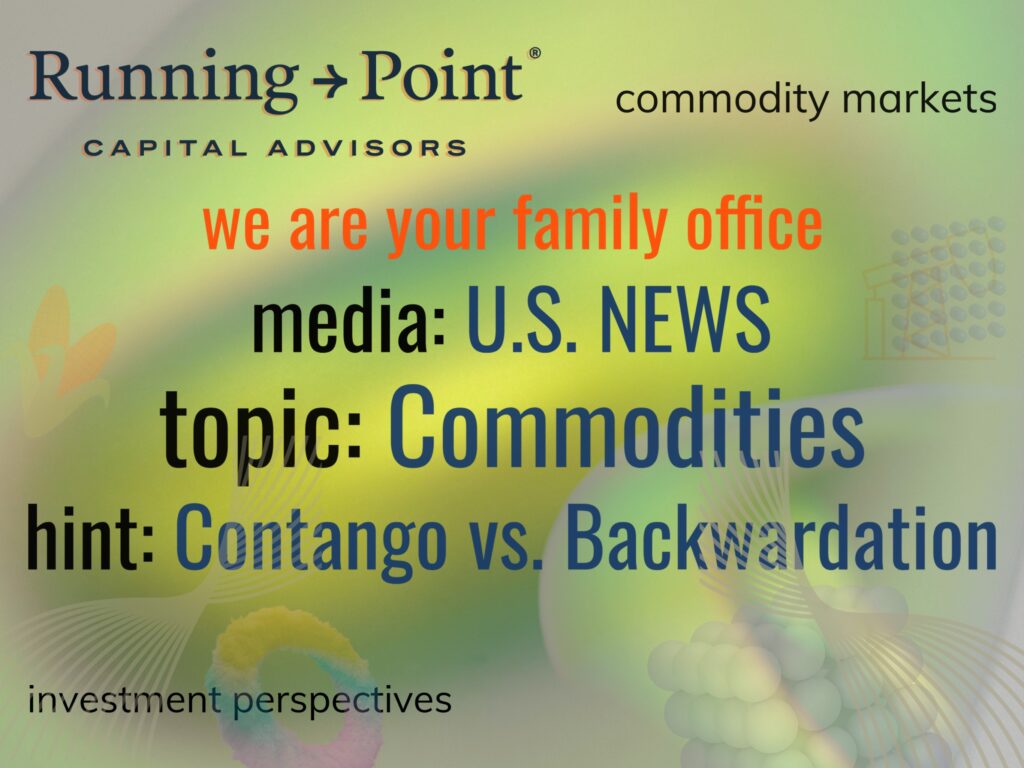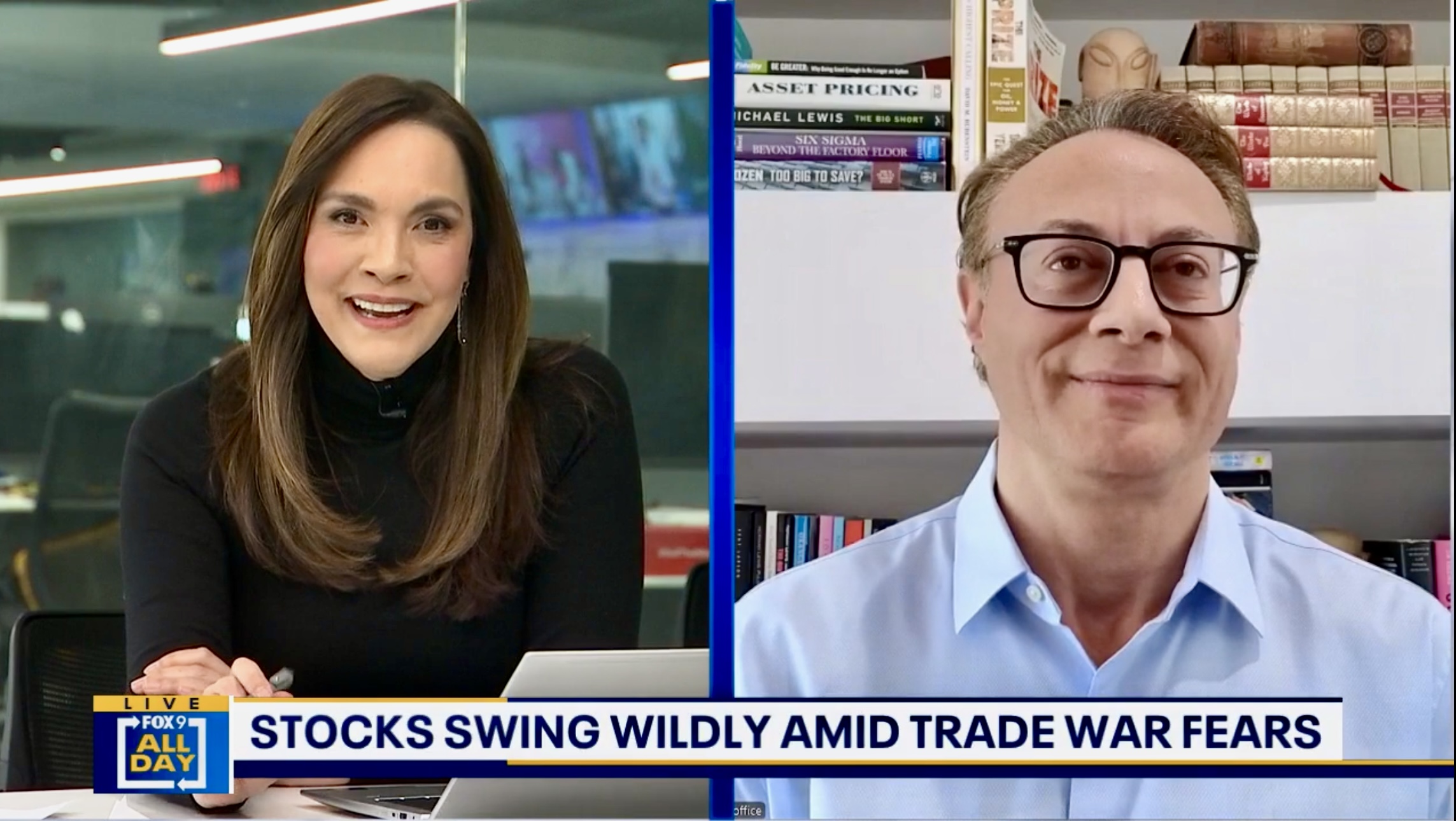What to know about contango vs. backwardation
Running Point and its chief investment officer, Michael Ashley Schulman, CFA were quoted by U.S. News & World Report in an article — by reporter Marc Guberti, “Contango vs. Backwardation: What’s the Difference?” — regarding two specific technical indicators, contango and backwardation, that act as opposites.
Cool names for a yacht ⛵
Besides being very cool yacht names, contango and backwardation refer to situations in commodity futures markets where the futures contract trades at a discount or premium to the expected market price at contract expiration.
- 📈Contango occurs when the futures price curve is upward slopping and the price of a commodity in the future is higher than the current market or spot price.
- 📉Backwardation is just the opposite and for many commodities is considered the normal (downward sloping) price curve because short-term supply fears have a tendency to drive up the current/spot price above the future price.
Contango📈
When a market is in Contango, people or companies are willing to pay more for something in the future (like jet fuel) in order to guarantee delivery at a future date; thus, future delivery prices are anticipated to be higher than current market prices. This can occur when there is either low demand or excess supply at the moment but expectations are that there will be more demand or less supply in the future. Events such as wars, refinery outages, mines shut down by a strike, government takeovers, or inclement weather tend to lessen future supply and drive up future prices.
Backwardation📉
Backwardation is the opposite of contango. It happens when the futures price is lower than the current market price (spot price), indicating an expectation of lower prices in the future often because of excess expected supply from a bumper crop yield or new supply coming online.
Trading the market
There is no guaranteed method of profiting from a backwardation or contango market. In a contango market, you might buy a near-term futures contract and simultaneously sell a longer-dated futures contract in the hope that what you sold drifts down the price curve and what you bought remains stable or increase in price. With a market in backwardation, you might attempt to profit from the opposite.
Main factors that contribute to contango or backwardation include interest rates or financing costs, storage and insurance costs, market expectations of investors, speculators, and hedgers, and supply and demand dynamics triggered by seasonality, technology, or governments.
Trading in futures markets involves sizable risks, especially when margin or borrowing is employed. You should carefully consider market conditions, transaction costs, and your risk tolerance before engaging in such strategies or enlist the guidance of a multifamily office or trusted financial advisor. The profitability of these trades depends largely on good execution, accurate predictions of future price movements, and the timing of market and globa-macro events.
Considerations
Investors should carefully assess the reasons behind a commodity’s discount, premium, or general price chart, considering whether it is due to temporary market conditions or longer term trends or fundamentals.
Quoted article excerpts are below:
During contango, an asset is projected to gain value over time based on the futures price exceeding the spot price. Backwardation is the opposite, just like the trading approaches. Profitable trading strategies for contango won’t work for backwardation, and vice versa.
“In a contango market, you might buy a near-term futures contract and simultaneously sell a longer-dated futures contract in the hope that what you sold drifts down the price curve and what you bought remains stable or increases in price,” says certified financial planner Michael Ashley Schulman. “With a market in backwardation, you might attempt to profit from the opposite.”
Profits are not guaranteed with any trading strategy or technical indicator. Schulman says there are a few details to keep in mind before making any trades: “Main factors that contribute to contango or backwardation include interest rates or financing costs, storage and insurance costs, market expectations of investors, speculators and hedgers, and supply and demand dynamics triggered by seasonality or technology.”
Contango and backwardation can each last longer than most traders anticipate. Doing your homework and knowing your stance on the direction of markets can help you decide which short-term and long-term futures contracts to trade.
Contango and backwardation give traders more insights, but they do not guarantee profits. For example, although backwardation indicates that prices are likely to decline in the future based on the gap between the spot price and the futures price, shifts in the economic climate and various factors can prolong backwardation or quickly put an end to the trend. The market can change rapidly based on a single economic data point, report or event. Volatile markets can present many false signals for traders and can lead to unprofitable trades.
“The profitability of these trades depends largely on good execution, accurate predictions of future price movements, and the timing of market and global macro events,” Schulman explains.
Contango and backwardation are trailing indicators that give you a snapshot of what is currently happening without offering a clear view of what will happen in the future. It’s also possible to receive mixed signals from multiple technical indicators. A trader may have various bearish technicals along with contango, a bullish signal. Traders have to decide if they will make decisions based on the bullish signals or the bearish signals that show up simultaneously on their dashboards.

My first proper job was as a commodities broker. I went off to work every morning in an ’80s power suit. I couldn’t afford a good one, so I’d buy nice buttons instead and make it look better than it actually was.
Trinny Woodall, British beauty entrepreneur, businesswoman, fashion expert, TV presenter, and author
Disclosure: The opinions expressed are those of Running Point Capital Advisors, LLC (Running Point) and are subject to change without notice. The opinions referenced are as of the date of publication, may be modified due to changes in the market or economic conditions, and may not necessarily come to pass. Past performance is not indicative of future results. Forward-looking statements cannot be guaranteed. Running Point is an investment adviser registered with the U.S. Securities and Exchange Commission. Registration does not imply a certain level of skill or training. More information about Running Point’s investment advisory services and fees can be found in its Form ADV Part 2, which is available upon request. RP-24-07


